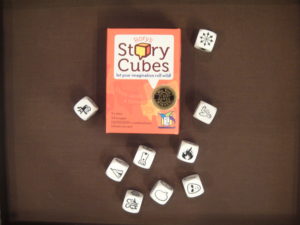I found these in Barnes & Noble awhile back and thought they’d be a fun travel item or a restaurant activity for the kids while we waited for our food to arrive. Honestly, I’m not sure I ever used them personally. They were so perfectly suited for therapy they went in my bag almost immediately, and there they stayed.
Rory’s Story Cubes are a set of nine dice, each one having six unique pictures. You roll the dice and use the pictures as storymaking prompts. Here are a few ideas for bringing them into your own treatment room:
Articulation:
Phrases: You can decide on an appropriate carrier phrase with the target sound and repeat it with each die. Ex. “Larry likes (books). Larry likes (rainbows).”
Carryover: Name each of the pictures rolled. Some allow interpretation, so you can skew the vocabulary to your target sound (ex. “castle” or “tower”). Now have the child tell you a story incorporating the die.
Language:
Sequencing: Nine dice would require some pretty capable narrative skills. I would have the child roll all nine dice and divide them into three groups of three. Have them tell a story or sequence of events, offering prompts as needed.
Wh- questions: Have the child roll all the dice and then ask, “Which dice show where/who/what?” This might be tricky, especially if you happen to have a roll in which there is no answer for a category. Once you’ve figured out which dice answer which part you can combine them into various silly sentences. Ex. “The ghost saw a bee on the airplane.” “The alien ate an apple in the house.”
Memory:
What’s missing? This could be a fun icebreaker for a group or a fun activity for voice, fluency or memory. Roll out the dice (you’ll need to decide if all 9 are an appropriate array). Give the child 30-60 seconds to study them, then have them close their eyes. Remove one die. Can they figure out which one is gone? Bonus points if they can create a story as to why the die is missing. Ex. “A jeweler snuck in and took the “scale” to weigh his new shipment of gold.”
I’m going to market or on vacation: I think of this as a classic roadtrip game. The first player says, “I’m going to market to buy (______).” The next player says, “I’m going to market to buy a (new object) and a (object named by player 1).” You keep going until someone can’t remember the list sequence. In this version, I would have the children remove the die with the picture they list and hold it in their hand. The kids would then be able to give a picture prompt as needed to another player struggling with the sequence. If you have a child with very low language skills, you could simply place the dice in the sequence so the picture prompts are always visible. Another variation is to say “I’m going on vacation and I’m packing….”
Stay on a roll by subscribing today and I’ll send you the password for the free speech diplomas!







This Post Has 8 Comments
There’s an app too!
I had no idea! TH-anks (last child was working on initial TH)! Kim
Nice idea! I’ll check them out. I love your blog, even though I work with adults in the hospital, many of your posts apply to me. If you are able to include us medical peeps in your thoughts and ideas- we’d love it! You are such a great resource.
Kristin, I always appreciate your input and I’m glad to hear you can make my ideas work for you. It’s been a long time since I’ve been in a medical setting so I’m not sure I’m the best candidate for those kinds of ideas. Anyone care to make a recommendation? Kim
What an awesome idea……can also get great critical thinking when working on the silly sentences and asking the higher level ‘wh’ questions such as “why couldn’t a ghost see a bee on an airplane?” thanks for sharing.
And thanks for adding on–that’s another great idea! Kim
Comments are closed.